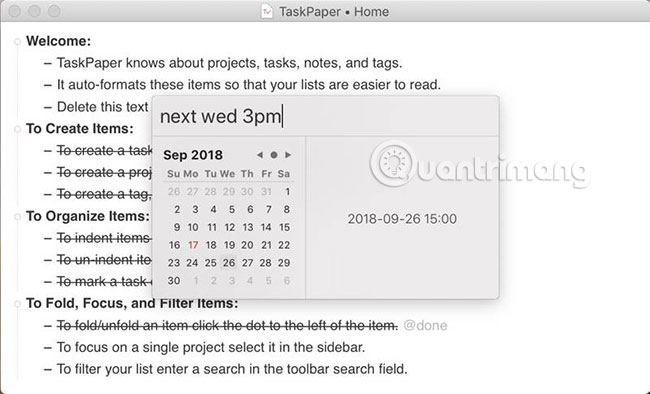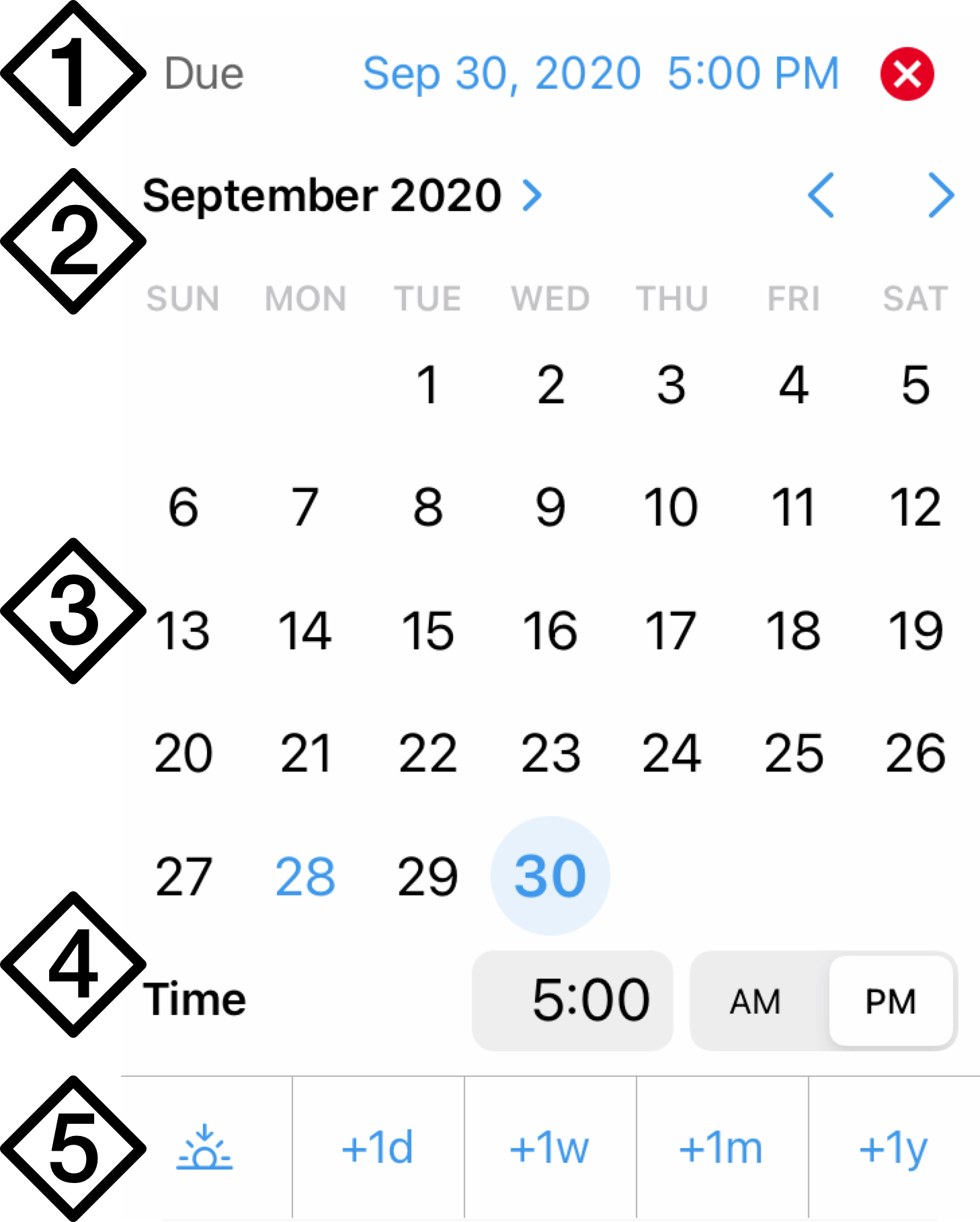Taskpaper – Plain Text To Dos 3 7 7
- TaskPaper features. Getting Things Done couldn’t be any simpler with TaskPaper. Make plain text lists of everything important to you, easy editable anywhere. The interface is distraction-free so you can concentrate on tasks rather than complex settings. So here’s your first simple to-do list: 1) Install TaskPaper 2) Type in tasks 3) Enjoy.
- For those that don’t remember, I keep my to do lists in plain text files and store them in a Dropbox folder. I use a specific format for these to do files called taskpaper. Taskpaper format primer. The taskpaper format is pretty simple. Tasks are lines that start with a hyphen: - task 1 - task 2 - task 3. Tasks can be organized by projects.
- TaskPaper is a plain text to-do list that’s surprisingly adept. Getting things done since 2006. Buy Now Download Text editor with outlining power. TaskPaper feels like a plain text editor, but it is backed by a powerful outliner. Keyboard friendly. Type your lists into TaskPaper and each line is formatted into a project, task,.

gistfile1
Plain text: Keyboard friendly. Type your lists into TaskPaper and each line is formatted into a project, task, or note. No locks: TaskPaper files are future proof. Edit them in any text editor or use one of the many TaskPaper compatible apps created by other developers. Outliner power: Fold, focus, and filter to cut big lists down to size. TaskPaper – Plain text to-dos PC 용. 카테고리: Productivity 최근 업데이트: 2021-02-09 현재 버전: 3.8.13 파일 크기: 7.85 MB 개발자: Hog Bay Software 호환성: 필요 Windows XP, Windows Vista, Windows 7, Windows 8, Windows 8.1 and Windows 10.

| -- Quite a lot modified to input text into a plain text file like used by taskpaper. Originally based somewhere back in time on Efficient Computing's AppleScript: http://efficientcomputing.commons.gc.cuny.edu/2012/03/17/copy-email-message-in-mail-app-to-evernote-applescript/ |
| tell application 'Mail' |
| --get selected messages |
| set theSelection to selection |
| --loop through all selected messages |
| repeat with theMessage in theSelection |
| --get information from message |
| set theMessageDate to the date received of theMessage |
| set theMessageSender to sender of theMessage |
| set theMessageSubject to the subject of the theMessage |
| set theMessageContent to the content of theMessage |
| set theMessageURL to 'message://%3c' & theMessage's message id & '%3e' |
| --make a short header |
| set theHeader to the all headers of theMessage |
| set theShortHeader to (paragraph 1 of theHeader & return & paragraph 2 of theHeader & return & paragraph 3 of theHeader & return & paragraph 4 of theHeader & return & return) |
| --import message to text file |
| my WriteLog('- resolve: ' & theMessageSubject & ' from ' & (word 1 of theMessageSender) & ' ' & (character 1 of word 2 of theMessageSender) & '.') |
| end repeat |
| end tell |
| on WriteLog(the_text) |
| set this_story to the_text |
| --set this_file to (((path to desktop folder) as text) & 'test.txt') |
| set this_file to (POSIX file '/Users/tbendt/Dropbox/_Tim/Projects/projects.TODO.taskpaper') |
| my prepend_to_file(this_story, this_file) |
| end WriteLog |
| on prepend_to_file(this_data, target_file) -- (string, file path as string, boolean) |
| try |
| --set the target_file to the target_file as text |
| open for access target_file |
| set fileContents to (read target_file from 7 to eof) |
| close access target_file |
| set the open_target_file to ¬ |
| open for access file target_file with write permission |
| set newInboxData to 'Inbox:' & return & this_data |
| --set fileContent to searchAndReplace(fileContents, 'Inbox:', newInboxData) |
| --write fileContents to the open_target_file starting at 0 |
| write newInboxData & fileContents to the open_target_file starting at 0 |
| close access the open_target_file |
| return true |
| on error |
| try |
| close access file target_file |
| end try |
| return false |
| end try |
| end prepend_to_file |
Sign up for freeto join this conversation on GitHub. Already have an account? Sign in to comment
Taskpaper – Plain Text To Dos 3 7 7 2 8 Answer
I have recently started using TaskPaper from Hog Bay Software on my iMac and MacBook. I have been mostly using GTD with paper-based systems (3-ring binder, or index cards) but recently wanted to look at apps so I could have some of my action items linked directly to Gmail (a lot of tasks come in through email) and to pull out actions by context from both project lists and action lists into single context lists. I really like TaskPaper http://www.hogbaysoftware.com/products/taskpaper because of its beautiful simplicity, the ability to focus on just the actions or project (like I can do with a paper-based system), and its good tagging capabilities.
Right now the version I am using (2.2) is still in development and is available from the TaskPaper wiki page http://www.hogbaysoftware.com/wiki/TaskPaper. This version adds some nice features like syncing and saved searches. If you prefer not to use software that is still being worked on, you can download http://www.hogbaysoftware.com/products/taskpaper, the current, stable version.
In addition to what TaskPaper does, I also like it for what it doesn't do. It doesn't have a lot of extraneous information going on. I don't need to know how many actions are uncompleted, I don't need due dates on my action lists. If something is due by a specific date it goes on my calendar or in my tickler file. (There is, however, an AppleScript to use due dates in TaskPaper if you really need them). I don't need to see all my other project lists when I'm working from a project or task list. I don't need to see toolbars, etc. when I'm focusing on just the tasks.
Some of the features of TaskPaper I like are:
• The data is stored in a plain text file. If for some reason I could not launch TaskPaper, I could still see my data through any text editor.
• Items are easy to add. Type a dash followed by text to create an action. Type the name of a project followed by a colon to create a project. Notes are just plain text. An @ followed by text creates a tag.
• Notes can be attached to a project or to a task.
• Smart links make each context tag, such as @home, a link to a view of all items with that tag.
• Access a TaskPaper quick entry window from any app with customizable keystrokes.
• Use the Services menu to create an entry from selected text in another app (Turn this on in Services Preferences, it's called 'New Entry').
• Drag and drop a url to create a task with a link to the url. (I use this a lot with links to Gmail messages).
• Link to a file from a task or a note.
• Hide everything (toolbar, sidebar) and show only the action items.
• I can syncronize my TaskPaper file between my iMac and my MacBook via a website.
• There is an active, friendly forum with developer participation.
• I can process the Inbox by dragging and dropping tasks and notes to projects and other lists, can also select multiple items to process. Can also use cut and paste for rearranging items.
• TaskPaper has lots of keystroke shortcuts like Command-Command to popup a little search window when you have the Toolbar hidden.
• Automatically append completed date to action item with the @done tag (Command-D). (Turn this on/off in the Preferences).
• Use Boolean expressions in searches and save the searches. For example: @places and not @done.
• Use multiple tabbed views.
• Global search
• Focus on one project or one list at a time or show everything at once. Just click on a project or select a tag from the pulldown or Command-L for the list.
• Nest tasks, projects, notes, simply use the tab key to indent the items
• Add multiple tags to items (for example, @home @today)
and last but not least...
• It's not too expensive!
There is also a PC version called TodoPaper (link is on Hogbay's website).
Right now the version I am using (2.2) is still in development and is available from the TaskPaper wiki page http://www.hogbaysoftware.com/wiki/TaskPaper. This version adds some nice features like syncing and saved searches. If you prefer not to use software that is still being worked on, you can download http://www.hogbaysoftware.com/products/taskpaper, the current, stable version.
In addition to what TaskPaper does, I also like it for what it doesn't do. It doesn't have a lot of extraneous information going on. I don't need to know how many actions are uncompleted, I don't need due dates on my action lists. If something is due by a specific date it goes on my calendar or in my tickler file. (There is, however, an AppleScript to use due dates in TaskPaper if you really need them). I don't need to see all my other project lists when I'm working from a project or task list. I don't need to see toolbars, etc. when I'm focusing on just the tasks.
Some of the features of TaskPaper I like are:
• The data is stored in a plain text file. If for some reason I could not launch TaskPaper, I could still see my data through any text editor.
• Items are easy to add. Type a dash followed by text to create an action. Type the name of a project followed by a colon to create a project. Notes are just plain text. An @ followed by text creates a tag.
• Notes can be attached to a project or to a task.
• Smart links make each context tag, such as @home, a link to a view of all items with that tag.
• Access a TaskPaper quick entry window from any app with customizable keystrokes.
• Use the Services menu to create an entry from selected text in another app (Turn this on in Services Preferences, it's called 'New Entry').
• Drag and drop a url to create a task with a link to the url. (I use this a lot with links to Gmail messages).
• Link to a file from a task or a note.
• Hide everything (toolbar, sidebar) and show only the action items.
• I can syncronize my TaskPaper file between my iMac and my MacBook via a website.
• There is an active, friendly forum with developer participation.
• I can process the Inbox by dragging and dropping tasks and notes to projects and other lists, can also select multiple items to process. Can also use cut and paste for rearranging items.
• TaskPaper has lots of keystroke shortcuts like Command-Command to popup a little search window when you have the Toolbar hidden.
• Automatically append completed date to action item with the @done tag (Command-D). (Turn this on/off in the Preferences).
• Use Boolean expressions in searches and save the searches. For example: @places and not @done.
• Use multiple tabbed views.
• Global search
• Focus on one project or one list at a time or show everything at once. Just click on a project or select a tag from the pulldown or Command-L for the list.
• Nest tasks, projects, notes, simply use the tab key to indent the items
• Add multiple tags to items (for example, @home @today)
and last but not least...
• It's not too expensive!
There is also a PC version called TodoPaper (link is on Hogbay's website).